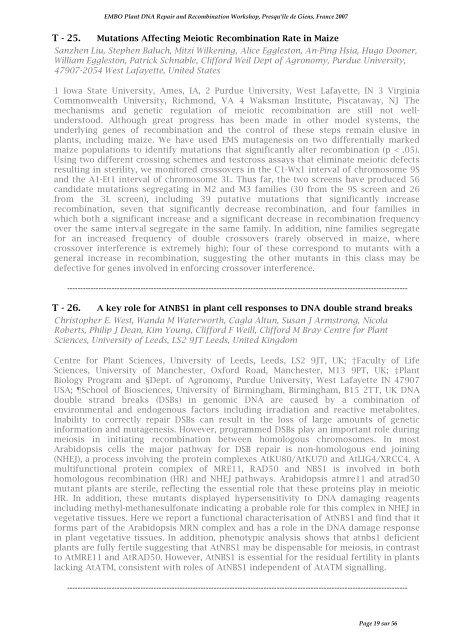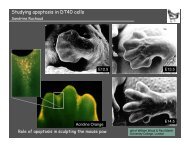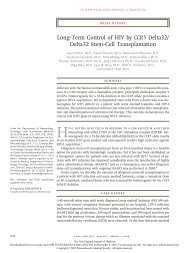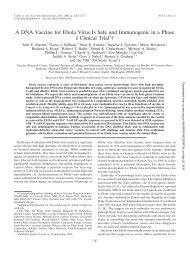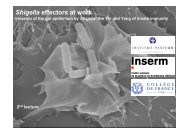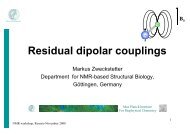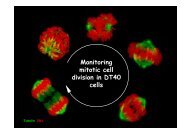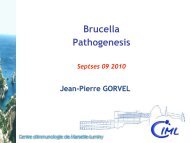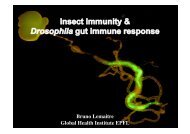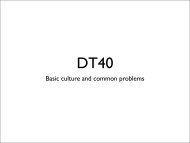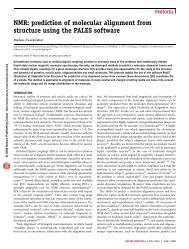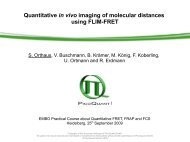pdf file - Events - EMBO
pdf file - Events - EMBO
pdf file - Events - EMBO
Create successful ePaper yourself
Turn your PDF publications into a flip-book with our unique Google optimized e-Paper software.
<strong>EMBO</strong> Plant DNA Repair and Recombination Workshop, Presqu'île de Giens, France 2007<br />
T - 25. Mutations Affecting Meiotic Recombination Rate in Maize<br />
Sanzhen Liu, Stephen Baluch, Mitzi Wilkening, Alice Eggleston, An-Ping Hsia, Hugo Dooner,<br />
William Eggleston, Patrick Schnable, Clifford Weil Dept of Agronomy, Purdue University,<br />
47907-2054 West Lafayette, United States<br />
1 Iowa State University, Ames, IA, 2 Purdue University, West Lafayette, IN 3 Virginia<br />
Commonwealth University, Richmond, VA 4 Waksman Institute, Piscataway, NJ The<br />
mechanisms and genetic regulation of meiotic recombination are still not wellunderstood.<br />
Although great progress has been made in other model systems, the<br />
underlying genes of recombination and the control of these steps remain elusive in<br />
plants, including maize. We have used EMS mutagenesis on two differentially marked<br />
maize populations to identify mutations that significantly alter recombination (p < .05).<br />
Using two different crossing schemes and testcross assays that eliminate meiotic defects<br />
resulting in sterility, we monitored crossovers in the C1-Wx1 interval of chromosome 9S<br />
and the A1-Et1 interval of chromosome 3L. Thus far, the two screens have produced 56<br />
candidate mutations segregating in M2 and M3 families (30 from the 9S screen and 26<br />
from the 3L screen), including 39 putative mutations that significantly increase<br />
recombination, seven that significantly decrease recombination, and four families in<br />
which both a significant increase and a significant decrease in recombination frequency<br />
over the same interval segregate in the same family. In addition, nine families segregate<br />
for an increased frequency of double crossovers (rarely observed in maize, where<br />
crossover interference is extremely high); four of these correspond to mutants with a<br />
general increase in recombination, suggesting the other mutants in this class may be<br />
defective for genes involved in enforcing crossover interference.<br />
----------------------------------------------------------------------------------------------------------------------------------<br />
T - 26. A key role for AtNBS1 in plant cell responses to DNA double strand breaks<br />
Christopher E. West, Wanda M Waterworth, Cagla Altun, Susan J Armstrong, Nicola<br />
Roberts, Philip J Dean, Kim Young, Clifford F Weill, Clifford M Bray Centre for Plant<br />
Sciences, University of Leeds, LS2 9JT Leeds, United Kingdom<br />
Centre for Plant Sciences, University of Leeds, Leeds, LS2 9JT, UK; †Faculty of Life<br />
Sciences, University of Manchester, Oxford Road, Manchester, M13 9PT, UK; ‡Plant<br />
Biology Program and §Dept. of Agronomy, Purdue University, West Lafayette IN 47907<br />
USA; School of Biosciences, University of Birmingham, Birmingham, B15 2TT, UK DNA<br />
double strand breaks (DSBs) in genomic DNA are caused by a combination of<br />
environmental and endogenous factors including irradiation and reactive metabolites.<br />
Inability to correctly repair DSBs can result in the loss of large amounts of genetic<br />
information and mutagenesis. However, programmed DSBs play an important role during<br />
meiosis in initiating recombination between homologous chromosomes. In most<br />
Arabidopsis cells the major pathway for DSB repair is non-homologous end joining<br />
(NHEJ), a process involving the protein complexes AtKU80/AtKU70 and AtLIG4/XRCC4. A<br />
multifunctional protein complex of MRE11, RAD50 and NBS1 is involved in both<br />
homologous recombination (HR) and NHEJ pathways. Arabidopsis atmre11 and atrad50<br />
mutant plants are sterile, reflecting the essential role that these proteins play in meiotic<br />
HR. In addition, these mutants displayed hypersensitivity to DNA damaging reagents<br />
including methyl-methanesulfonate indicating a probable role for this complex in NHEJ in<br />
vegetative tissues. Here we report a functional characterisation of AtNBS1 and find that it<br />
forms part of the Arabidopsis MRN complex and has a role in the DNA damage response<br />
in plant vegetative tissues. In addition, phenotypic analysis shows that atnbs1 deficient<br />
plants are fully fertile suggesting that AtNBS1 may be dispensable for meiosis, in contrast<br />
to AtMRE11 and AtRAD50. However, AtNBS1 is essential for the residual fertility in plants<br />
lacking AtATM, consistent with roles of AtNBS1 independent of AtATM signalling.<br />
----------------------------------------------------------------------------------------------------------------------------------<br />
Page 19 sur 56


